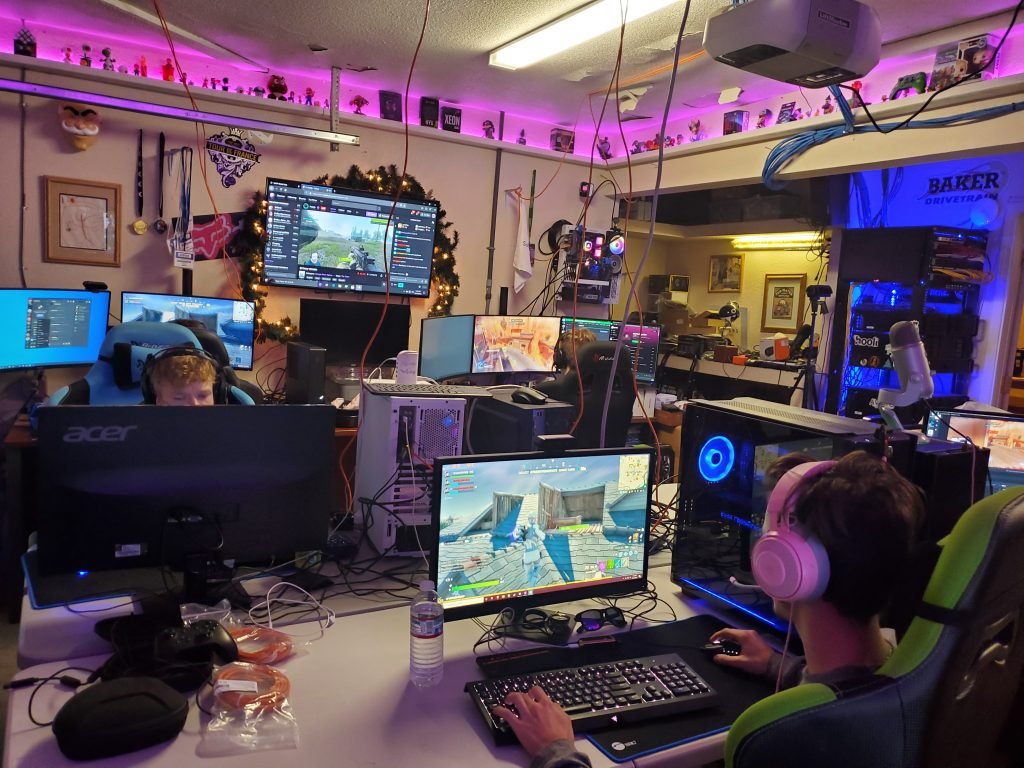Quick math
One 15/20 AMP breaker/circuit for 3 PCs (1 PC = 1 tower & 1 monitor).
Formula: Amps × Volts = Watts
- 15 × 120 = 1,800W → ÷ 3 = ≈ 600W per PC
- 20 × 120 = 2,400W → ÷ 3 = ≈ 800W per PC
Capacity planning
- 2-car garage = 20 PCs
- 1-car garage = 10 PCs
- 20 PCs = 36,000 Watts (planning figure; verify with a licensed electrician)
- 20 PCs ≈ 7 circuits (plan to add extra for networking, server(s), HVAC, peripherals like printers and tools.)
Layout tips
- Ceiling outlets help power 10 people at the center tables of a 20-person, 2-car-garage LAN. Add ceiling LAN drops by these outlets too.
- Keep ethernet and power extension cords a foot or more apart to reduce interference.
HVAC: Consider installing a unit for the garage (for a 2-car garage, a 2 ton unit worked well here).
Sub-panel: After checking with your power company or a locally licensed electrical contractor, you can add a sub panel off the main breaker panel to supply additional circuits.
Real-world power draw
“600 Watts per PC — but my PC has a 750 Watt PSU!”
- PC components rate hardware at max power consumption and include a headroom/“flux” factor.
- A GPU might say it requires a 650W PSU — that budget covers the whole system and worst-case spikes.
- Most modern builds use motherboard power for M.2 storage, a single 2.5″ SSD (~2 Watts), and a GPU. Air coolers run off the motherboard; many AIOs power their own fans.
Bottom line: you’re not using what you think you’re using, but it’s close — plan conservatively.
High-end rigs
Put custom-loop rigs with big pumps or multi-GPU miners on their own circuit, or at most 2 PCs per circuit.
Personal note: building PCs with the crew
For my kids and their friends: to join the LAN, they initially brought their own PC from home. We opened it up together, learned and troubleshot, then made a trip to Fry’s Electronics (RIP) to buy parts for a new build. (Fry’s gave me an awesome 30% off for doing this!)
Each build got a Corsair AX860 ATX PSU for efficiency and to future-proof. Early builds used Intel “K” i7s and EVGA 970/1070 (70-series) on MSI “Z” boards; later we moved to Intel non-K CPUs on mITX boards with Samsung 2.5″ & M.2 SSDs to better control power draw.
If they could build it (everyone helped) and it booted, they kept the PC — no need to “owe” me back. 10+ years later I still hear about those rigs running, sometimes carrying folks through school. Huge thanks to everyone at Fry’s — much luv!
